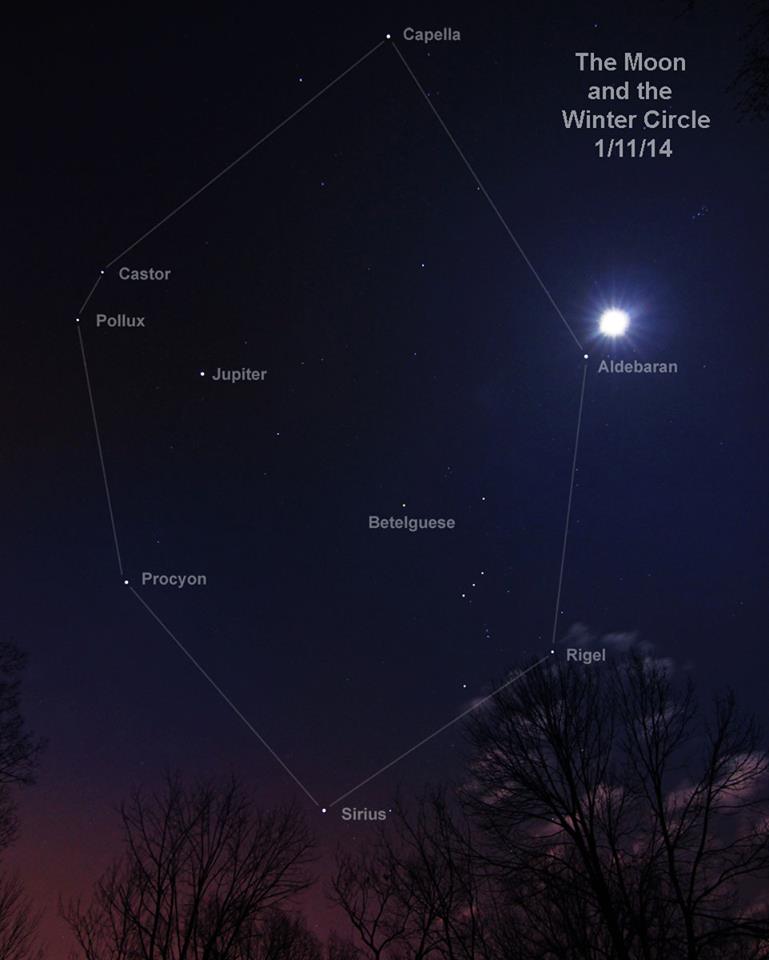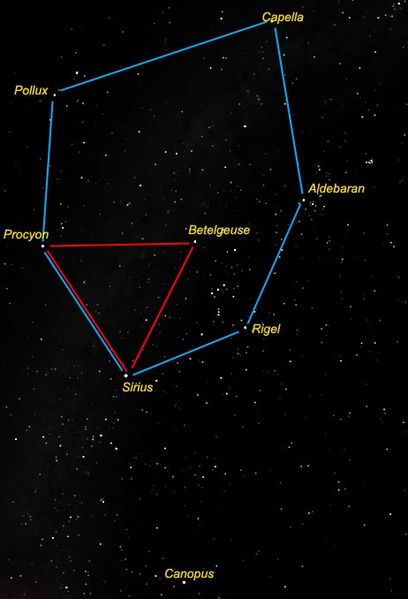
Jupiter was found inside the Winter Circle in 2014. Every month the Circle is visible, the moon sweeps through it. Photo by EarthSky Facebook friend Duke Marsh in Indiana.
The Winter Hexagon – sometimes also called the Winter Circle – is a collection of some of the brightest winter stars in the Northern Hemisphere. The Winter Hexagon isn’t a constellation but an asterism, or prominent group of stars that form a pattern so noticeable it has a separate name. The Winter Hexagon has a smaller asterism inside it – the Winter Triangle.
The Winter Hexagon is made of six 1st-magnitude stars from six different constellations: Rigel in Orion, Aldebaran in Taurus, Capella in Auriga, Pollux in Gemini, Procyon in Canis Minor, and Sirius in Canis Major. An additional 1st-magnitude star, Betelgeuse in Orion, lies toward the center of the Hexagon.
EarthSky lunar calendars are back in stock! We’re guaranteed to sell out. Get one while you can!
By the Northern Hemisphere’s winter solstice, around December 21, the Winter Hexagon will have risen high enough above the northeastern horizon to be seen by about 9 p.m. local time. If you wait until 1 a.m., the Winter Hexagon will be high above the southern horizon. And by 5 a.m., it sinks toward the southwestern horizon. The western (right) half of the Winter Hexagon, including Aldebaran, Rigel and Sirius, sets in the west before sunrise.
Like all stars, those in the Winter Hexagon rise and set some 4 minutes earlier with each passing night. By late January, the Winter Hexagon is found in the same places described above, about 2 hours earlier. In late February and early March, the Winter Hexagon is in your southern sky at nightfall and early evening.

Gowrishankar Lakshminarayanan on Long Island, New York, caught the moon inside the Winter Circle in early April 2017.
To find the Winter Hexagon or Circle, first find the easily recognizable constellation of Orion. The three belt stars give it away. Then look at the bright bluish star at lower right. This star is Rigel, the southwest corner of the Winter Circle and the first of the six stars in the Hexagon. Rigel is the brightest star in Orion and the seventh brightest star in the night sky.
Draw a line through Orion’s Belt stars upward to find Aldebaran, the ruddy eye in the constellation Taurus the Bull. Aldebaran is the second star in the Hexagon and the brightest star in Taurus. Aldebaran is the fourteenth brightest star in the sky.
Continue upward in a counterclockwise direction to find the next bright star, Capella. Capella, the third star on our journey and the northernmost point of the Winter Hexagon, is the sixth brightest star in the heavens.
As we start to wind down the face of our clock, we run into two bright stars, the twins in Gemini. Pollux, the brighter of the two, is our fourth corner in the hexagon, and its “twin,” Castor, is just a bit fainter. They mark the heads of the twins, who are also named Pollux and Castor, brothers from ancient mythology. Pollux is the sky’s 17th brightest star, and Castor is 24th.
Our second-to-last stop around the Winter Hexagon is the bright star below the twins, Procyon. Procyon is the brightest star in Canis Minor, and in fact one of only two named stars in the constellation. For such a “minor” constellation, Procyon shines brilliantly as the seventh brightest star in the sky.
Lastly we come down to the southernmost star in the Winter Hexagon and the brightest of them all: Sirius. Sirius is the brightest not only in the Winter Hexagon but in the entire night sky. Only the moon and some planets can outshine Sirius.
To find the Winter Triangle, take the last two stars, Sirius in Canis Major and Procyon in Canis Minor, then head toward the center of the Hexagon to find reddish Betelgeuse, shoulder star in Orion, to make the third corner of the triangle. Betelgeuse is the 10th brightest star in the sky and second brightest star in Orion.
To get an idea of the asterism’s humongous size, the span from the southernmost star in the Hexagon, Sirius, to the northernmost star, Capella, covers about 1/3 of the dome of the sky.
For a bonus, on a dark and clear moonless night, you can look for the soft-glowing river of stars that we call the Milky Way, meandering right through the center of the Winter Hexagon.
Bottom line: The Winter Hexagon is a giant shape made from some of the brightest stars in the sky, including Rigel, Aldebaran, Capella, Pollux, Procyon and Sirius.
Enjoying EarthSky? Sign up for our free daily newsletter today!
from EarthSky https://ift.tt/2K99xpx

Jupiter was found inside the Winter Circle in 2014. Every month the Circle is visible, the moon sweeps through it. Photo by EarthSky Facebook friend Duke Marsh in Indiana.
The Winter Hexagon – sometimes also called the Winter Circle – is a collection of some of the brightest winter stars in the Northern Hemisphere. The Winter Hexagon isn’t a constellation but an asterism, or prominent group of stars that form a pattern so noticeable it has a separate name. The Winter Hexagon has a smaller asterism inside it – the Winter Triangle.
The Winter Hexagon is made of six 1st-magnitude stars from six different constellations: Rigel in Orion, Aldebaran in Taurus, Capella in Auriga, Pollux in Gemini, Procyon in Canis Minor, and Sirius in Canis Major. An additional 1st-magnitude star, Betelgeuse in Orion, lies toward the center of the Hexagon.
EarthSky lunar calendars are back in stock! We’re guaranteed to sell out. Get one while you can!
By the Northern Hemisphere’s winter solstice, around December 21, the Winter Hexagon will have risen high enough above the northeastern horizon to be seen by about 9 p.m. local time. If you wait until 1 a.m., the Winter Hexagon will be high above the southern horizon. And by 5 a.m., it sinks toward the southwestern horizon. The western (right) half of the Winter Hexagon, including Aldebaran, Rigel and Sirius, sets in the west before sunrise.
Like all stars, those in the Winter Hexagon rise and set some 4 minutes earlier with each passing night. By late January, the Winter Hexagon is found in the same places described above, about 2 hours earlier. In late February and early March, the Winter Hexagon is in your southern sky at nightfall and early evening.

Gowrishankar Lakshminarayanan on Long Island, New York, caught the moon inside the Winter Circle in early April 2017.
To find the Winter Hexagon or Circle, first find the easily recognizable constellation of Orion. The three belt stars give it away. Then look at the bright bluish star at lower right. This star is Rigel, the southwest corner of the Winter Circle and the first of the six stars in the Hexagon. Rigel is the brightest star in Orion and the seventh brightest star in the night sky.
Draw a line through Orion’s Belt stars upward to find Aldebaran, the ruddy eye in the constellation Taurus the Bull. Aldebaran is the second star in the Hexagon and the brightest star in Taurus. Aldebaran is the fourteenth brightest star in the sky.
Continue upward in a counterclockwise direction to find the next bright star, Capella. Capella, the third star on our journey and the northernmost point of the Winter Hexagon, is the sixth brightest star in the heavens.
As we start to wind down the face of our clock, we run into two bright stars, the twins in Gemini. Pollux, the brighter of the two, is our fourth corner in the hexagon, and its “twin,” Castor, is just a bit fainter. They mark the heads of the twins, who are also named Pollux and Castor, brothers from ancient mythology. Pollux is the sky’s 17th brightest star, and Castor is 24th.
Our second-to-last stop around the Winter Hexagon is the bright star below the twins, Procyon. Procyon is the brightest star in Canis Minor, and in fact one of only two named stars in the constellation. For such a “minor” constellation, Procyon shines brilliantly as the seventh brightest star in the sky.
Lastly we come down to the southernmost star in the Winter Hexagon and the brightest of them all: Sirius. Sirius is the brightest not only in the Winter Hexagon but in the entire night sky. Only the moon and some planets can outshine Sirius.
To find the Winter Triangle, take the last two stars, Sirius in Canis Major and Procyon in Canis Minor, then head toward the center of the Hexagon to find reddish Betelgeuse, shoulder star in Orion, to make the third corner of the triangle. Betelgeuse is the 10th brightest star in the sky and second brightest star in Orion.
To get an idea of the asterism’s humongous size, the span from the southernmost star in the Hexagon, Sirius, to the northernmost star, Capella, covers about 1/3 of the dome of the sky.
For a bonus, on a dark and clear moonless night, you can look for the soft-glowing river of stars that we call the Milky Way, meandering right through the center of the Winter Hexagon.
Bottom line: The Winter Hexagon is a giant shape made from some of the brightest stars in the sky, including Rigel, Aldebaran, Capella, Pollux, Procyon and Sirius.
Enjoying EarthSky? Sign up for our free daily newsletter today!
from EarthSky https://ift.tt/2K99xpx


Aucun commentaire:
Enregistrer un commentaire